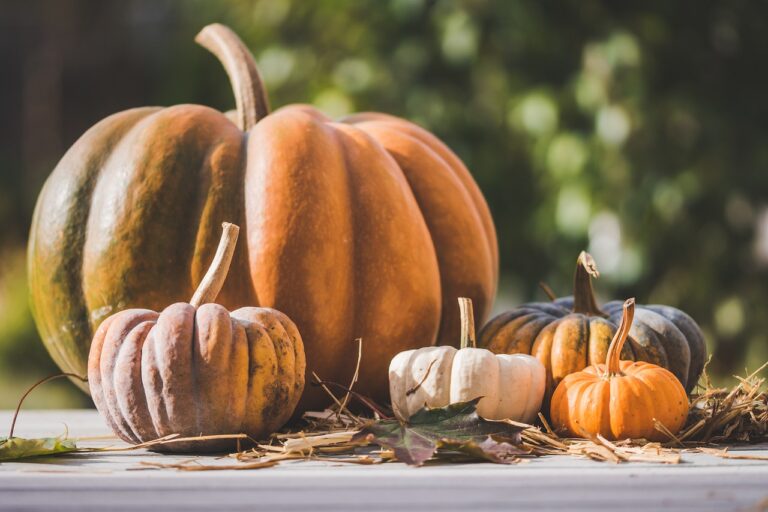
In the Northern hemisphere Autumn time is typically characterised by “Vata” type qualities, such as:- dry, rough, windy, erratic, cool, subtle, and clear. Vata consists of the elements air and ether. In Ayurveda like increases like and therefore Autumn is considered Vata season and as such it is the time that this dosha can easily become unbalanced.
To understand more about the Doshas click the link here:- http://amritaholistics.com/index.php/ayurveda/
For many people the energy of Autumn, coupled with going back to work or school, along with the shorter, darker, cooler days are met with feelings of anxiety, disrupted sleep patterns and digestive issues (these are also all signs of Vata imbalance).
What is supportive and balancing for each person depends on ones’ constitution (prakruti), and current condition (vikruti), location and stage of life. Therefore what brings balance person to person will vary, which is why it is important to find out and understand your unique constitution and imbalances first. If you are interested in this, I would be happy to discuss with you – connect with me for a free initial consultation.
However there are some underlying principles and themes we can take into account that will benefit all.
Many imbalances today are due to our disconnection from nature as well as from a lack of following the seasonal influences and knowing how to maintain our own health and well-being naturally. We need to tune in to our own rhythms and bodies and understand what is most beneficial for us – it is important to understand it is not a one size fits all approach.

Autumn: The Vata Season
Ayurveda considers a seasonal routine an important foundation of health all year round. As such seasonal routine, much like a daily routine can have a balancing effect on all doshas.
Balancing the nature of the local climate with lifestyle choices that offset the potential for seasonally-induced imbalances is one of the simplest ways that you can prevent illness and protect your overall health and well-being.
However it is important to bear in mind that the seasons vary widely from place to place, as do the qualities that accompany them.
“Vata season” is whatever time of year the climate and weather conditions most aptly represent the attributes that characterise vata dosha: dry, light, cold, rough, subtle, mobile, and clear (or empty).
Autumn is usually typically vata season. However, depending on where you live, the dry and expansive qualities of vata may also be the principal components of your environment in other seasons too—showing as early as summer, and if autumn is followed by a very drying, cold, isolating, or windy winter.
Cultivating awareness of the climate, the nature that surrounds us and its changes and the interconnectedness with our own systems is key in understanding oneself and responding from a space of alignment and balance.
When we become more aware and connected with ourselves and nature, beginning to observe the environment from this qualitative perspective enables one to respond to seasonal changes in the local climate as well as those within our own internal systems. You may be surprised to find that you may be naturally adopting seasonally appropriate habits already, perhaps without even being conscious of doing so.
For example, during summer we tend to opt for more cooling foods such as salads, watermelon, juices and fruits that also are naturally in season and abundance at that time of year. Whereas as the weather starts to cool down, we naturally tend to crave more warming and grounding foods such as soups, stews, baked breads and so on, which also naturally tend to pacify the dry, light, erratic Vata qualities of Autumn.
Looking to the diet is a powerful way to soothe vata as we move into the cooler months of Autumn. You may find yourself naturally wanting to increase your intake of food, however be mindful of your own constitution and listen to your own appetite and digestion.

Types of Food to Favour in Autumn
Substantial, nourishing foods that are high in protein, high in fat, oily (the right types of oils and fats), with the right balance of warming, stimulating spices, and served warm /hot, will help to keep one grounded and maintain internal moisture through the Vata season.
Favour the (naturally) sweet, sour, and salty tastes. In general, eat mushy, soft foods such as soups, dals (lentils), stews and garnish them generously with ghee or oil.
Breakfasts of cooked grains—such as oatmeal, tapioca, cream of rice, and cream of wheat—are perfect at this time of year.
Lunches and dinners that include steamed vegetables, hearty grains, soups, and stews are grounding and moisturising.
Dairy products and all nuts and seeds are also beneficial.
Ideal Autumn Foods:-
Fruits
Apples (cooked)
Avocados
Bananas
Dates
Figs
Grapefruit
Grapes
Lemons
Limes
Mangoes
Oranges
Papayas
Prunes (soaked)
Raisins (soaked)
Tangerines
Vegetables
Beets
Carrots
Chilies
Garlic
Okra
Onions
Pumpkins
Squash, Winter
Sweet Potatoes
Grains
Oats
Quinoa
Wheat
Amaranth
Brown Rice
Dairy
Butter
Buttermilk
Cheese
Cream
Ghee
Kefir
Milk (not cold)
Sour Cream
Yogurt
Oils & Fats (ensure they are cold pressed and organic where possible)
Almond Oil
Ghee
Olive Oil
Peanut Oil
Safflower Oil
Sesame Oil
Sweeteners
Honey
Jaggary
Maple Syrup
Molasses
Rice Syrup
Sugar (Raw)
Spices – Most are recommended at this time (but do note seasonal fluctuations)
Allspice
Anise
Asafoetida (Hing)
Basil
Bay Leaf
Black Pepper
Cardamom
Cinnamon
Clove
Cumin
Dill
Garlic
- Ginger
- Mustard Seeds
Nutmeg
Oregano
Paprika
Parsley
Rosemary
Saffron
- Turmeric
Foods to Keep to a Minimum
In general, one should reduce the consumption of raw vegetables, cold and frozen foods, as well as the bitter, pungent, and astringent tastes.
It is best to keep light, cooling, and drying foods, such as broccoli, cabbage, cauliflower, sprouts, leafy greens, white potatoes, beans, popcorn, crackers, millet, and dried fruit to a minimum.
If you do eat these foods, eat them in moderation and make sure that they are first soaked (in the case of pulses, nuts), well cooked, or served with ghee (in the case of dry foods).
Lifestyle Tips for the Autumn Transition

Practice a daily routine – One of the most effective ways to support Vata is by establishing a daily routine (dinacharya – as its known in Ayurveda). Try to do the same things (wake up, exercise, eat meals, go to bed, etc) at roughly the same times each day. Set the tone for your day by rising early, taking full advantage of the silence, stillness, and peace that are intrinsic to the early morning hours.
Abhyenga Massage / Self Massage – Calm your nervous system, awaken your muscles, tissues, circulation and ground your energy by massaging your skin with warm, organic sesame oil or a recommended Ayurvedic herbal oil. Follow this practice with a warm, relaxing shower, using minimal soap – so leaving a coat of oil on the skin to absorb throughout the day. Steam baths as well as humidifiers can help preserve internal moisture as well.
Yoga, Meditation & Pranayama – Some gentle yoga, pranayama (breath work) and meditation will greatly improve your sense of overall stability and wellness.
Aromatherapy – Use warming, grounding and uplifting aromas such as cypress, cinnamon, eucalyptus, bergamot, patchouli, palo santo, and orange essential oils are very appropriate and beneficial at this time of year. Essential oils can also help to cleanse the atmosphere ward off seasonal viruses, bacteria, germs and so on, so can also be preventative measure. Use in your home and or workspace in a diffuser for safest and effective method.
Dress for the season – Wear warming and uplifting autumn colours wherever possible, such as reds, yellows, oranges, pinks and whites—and wear enough clothes that you stay warm throughout the day. When you step out into the elements, do be sure to cover your head and ears to protect them from the wind and cold as necessary.
Yoga for Autumn

Incorporating a sense of warmth, grounding, stability, and focus into your yoga practice has a profoundly calming effect on Vata and, as such can work wonders during Vata season. Your breath should be deep and fluid.
Incorporating Pranayama (yogic breathing exercises),such as Nadi Shodhana (Alternate Nostril Breathing) is very balancing at this time of year.
Asanas that help with pacifying Vata, are warming up slowly, including some joint rotations, such as Pawanmuktasana series 1.
In your practice move with intention and fluidity—consciously grounding the hands and the feet on the mat whenever possible, whilst visualising your connection with the earth—and avoid jumping between postures.
Gentle flows, such as Sun Salutations are beneficial for Vata. Standing and balancing asanas such as Mountain, Warrior I, Warrior II and Tree Pose can help with feeling more grounded and also to increase stability and strength.
Connect with the earth beneath in asanas such as Thunderbolt, Cat-Cow, Cobra and Childs Pose. Forward bending practices can also help to quiet the mind.
Gentle inversions, such as Viparita Karani (where the legs are elevated, whilst laying on the back) and most restorative asanas are also very good for vata, helping to bring back balance and a sense of stability.
Ensure that asana practice is always concluded with an adequate Savasana (Corpse Pose) – at least 5 – 10 minutes, and ensure you stay warm by covering yourself with a blanket as necessary.
Herbal Support for Autumn

Ayurveda offers a number of herbs that can help balance Vata that hence, can be especially beneficial during the autumn season. Among them are:
- Chyavanprash – Is a medicinal concoction as described in the Ayurveda texts, containing ghee, honey, sugar, berries, herbs and spices (of which can range from between 30 – 80!), however the main ingredient is Amla (Indian Gooseberry), which is a nutrient rich berry packed full of vitamin C, and high in antioxidants. It is kind of like a jam and can be mixed with warm milk or water to drink. It is a potent immunity boosting mixture. Therefore taking a spoonful of Chyavanprash in the mornings, during this season can help reinforce immunity, strength, and energy at this time and can help to ward off seasonal flu and bugs.
- Ashwagandha – Is a powerful adaptogenic herb, that has a stabilising affect on the mind and nervous system. It can help promote a sound sleep, improve digestion, proper elimination, as well as improve strength, immunity and stamina. Ashwaghanda can be taken in powder, tablet or even liquid extract form.
- Herbal Teas – Herbal teas, such as those made with ginger, licorice, or CCF (cumin, coriander and fennel seeds) can help promote proper digestion and warmth. Recently I have been making a tea with fennel seeds, cinnamon powder, cardomon, cloves and star anise (optional if you have), which I really love. Simply take 1 teaspoon fennel seeds, quarter teaspoon cinnamon powder, grind 3 cardomom pods and 1 – 2 cloves in a pestle and mortar, add 1 star anise, add 1 – 2 cups of water and bring to the boil, allow to simmer for a few minutes, strain and pour in your favourite mug and once it has cooled a little – enjoy! I find that I do not even need to add jaggery or honey to sweeten this tea,- although you can if you prefer – I simply enjoy it as it is! This tea is slightly warming, comforting and gently detoxing. It is a great way to start the morning caffeine free!

Please note that the information contained within this article is based on my own experience and principles of healthy living from my knowledge of Ayurveda. The information, techniques and recommendations mentioned herein are not intended as a substitute for the medical advice of a qualified healthcare physician or Ayurvedic doctor. If in doubt, or if you may require diagnosis or medical attention, consult your healthcare provider before implementing or adopting any significant diet or lifestyle changes and taking any herbal supplements.
If you are interested to know more about how Ayurveda can support you in living a more balanced and healthy lifestyle please do not hesitate to reach out to me. Contact me to book in for a FREE clarity call.
This article is due to be published in the Focus on Health & Wellbeing Online magazine on 27th September 2023 – click the link below to view the article from this date.

